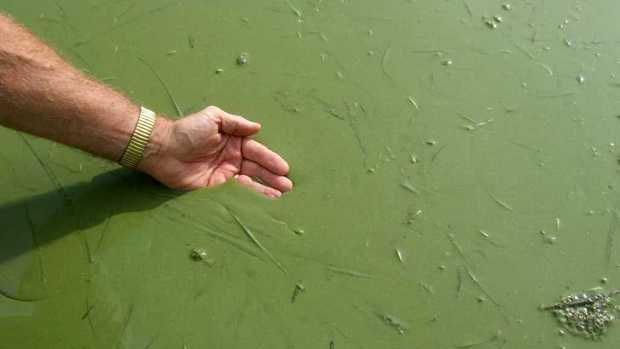In the fight against green slime on Lake Erie, farmers try to clean up their act
Cyanobacteria, or "green slime," is wreaking havoc with Lake Erie's water supplies and fishing industries. The outbreaks are caused largely by runoff of fertilizers and other nutrients from farms, and they're a growing problem in the Great Lakes and around the world.
Fishing boats line the docks near a small processing plant in Kingsville, Ontario, on the north shore of Lake Erie. But the stacks of brightly colored plastic crates to hold the day's usual catch of walleye and perch are sitting empty.
It’s a familiar site around here these days, and Dan Martin knows why. “It's the green slime, (the same stuff) that they're getting on the beaches in Ohio and Pelee Island," he says
What Martin calls green slime, scientists call cyanobacteria. It's also known as blue-green algae. Whatever you call it, Martin says, it's making things a lot harder for Lake Erie fishermen like him. That's because the algae basically sucks oxygen out of the water. The fish can't breathe, so they move somewhere else.
“[If] you stay ahead of them, you'll catch fish,” Martin says. “Where the slime is, they're not there.”
The green slime has become a regular event on Lake Erie, but it isn't just a problem for fish and fishermen. This is the same stuff that poisoned the drinking water in Toledo, Ohio, and elsewhere around the lake during the past two summers.
And the problem is mostly caused by growing the food that you and I eat: Scientists on both sides of the border agree that it's mostly pollution from farms and greenhouses that are fueling the Lake Erie algae blooms.
On a road just north of Kingsville, some of those giant greenhouses line the road. They grow peppers, winter tomatoes and other produce — and they go on forever. There are nearly 3,000 acres of them here.
Most crops need phosphorus to grow, but it can wreak havoc when farmers use too much and the excess runs off into local waterways. And Sean Anthony, a water quality expert for the local government, says it's clear some greenhouses here are releasing way too much.

But it's not just greenhouses that are choking lakes and rivers with nutrient pollution. It's also farmland, sewage systems and runoff from lawns. And it's happening around the world, not just in the Great Lakes, fueled mostly by a growing human appetite.
“What we're trying to do here is grow more and more food on less and less cropland,” says Doug Haffner, who runs the University of Windsor's Great Lakes Institute for Environmental Research.
“We're using more nutrients, more fertilizers, more pesticides, more herbicides,” Haffner says. “And of course, what we're doing is sacrificing our fresh water resources.”
Haffner says the water pollution problem is only getting worse with climate change, because more intense storms are washing away more soil and nutrients. But farmers in Ontario are finding ways to cut their pollution.
Some of these things are relatively simple, like planting cover crops to hold the soil. Others are a bit more complex.
Henry Denotter, who grows corn, soybeans, and wheat on about 1,500 acres just outside of Kingsville, uses an “air seeder” and other high-tech equipment.
Denotter’s tractors, sprayer and combine are equipped with precision instruments, including GPS systems, to track precisely where they are in the fields. He takes soil samples to see how much fertilizer is needed in different places, and his son, Jeremy, enters the data into a computer to create a “prescription map” for the fertilizer.
The air seeder then injects the fertilizer under the soil instead of spraying it on top, and applies just the right amount — and no more.
This kind of technology costs a lot of money, a lot more than many farmers can afford. But this year's toxic algae blooms have brought a new urgency to the problem, and the pressure on farmers to clean up their operations is growing. The joint US-Canadian agency that oversees water quality in the Great Lakes will release tougher phosphorus targets for Lake Erie next year.
That could mean lower profit margins for farmers here, and maybe even higher food prices. But ultimately, cutting down on waste should be in everyone's interest, whether it's to protect Lake Erie and drinking water supplies, or to protect a farmer's bottom line.
“You can't say we're not trying,” Jeremy Denotter says. “We are trying to protect it. Like Dad said, fertilizer's expensive. Why would we want to throw it away?”
